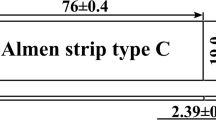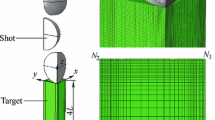Abstract
Shot peening is a mechanical process in which a component surface is subjected to the collision of thousands of small steel shots so inducing a compressive residual stress field that improves its fatigue resistance. Conventional numerical techniques, such as finite element method, are prohibitive to model the entire behavior of the media stream over the entire treated component because of the high computational cost. An alternative is to base such an analysis on the rigid body mechanics. Here, a multibody system approach was used to model the global shot peening process when applied on a leaf spring. Two thousands shot spheres impelled by a two-wheel peening machine were included in the model. Both dimensions and peening parameters were extracted from an experimental test developed also in this study. Graphical results allowed finding out some important aspects as the media trajectories, media interference, and the identification of the high peening intensity points. All these aspects resulted to be important for evaluating the peening arrangement efficacy. In addition, the media velocity and the peening coverage, both indispensables to assess the treatment of the peened component, were also obtained.



















Similar content being viewed by others
Abbreviations
- a c :
-
Centrifugal acceleration of the media, m s−2
- B :
-
Length of the wheel blade, mm
- d :
-
Diameter of the media, mm
- d i :
-
Average diameter of the media indentation, mm
- d 0 :
-
Diameter of the reference shot media, mm
- C :
-
Peening coverage, %
- C A :
-
Peening coverage for area coverage model, %
- C L :
-
Peening coverage for linear coverage model, %
- D ind :
-
Shot indentation diameter, mm
- flux:
-
Media flux, m−1s−1
- F 0 :
-
Media flux constant, s−1
- f A :
-
Almen intensity, mm
- k :
-
Correction factor of radial velocity due to friction, dimensionless
- L :
-
Length unit, m
- n :
-
Density of media indentations, m−1 and m−2 (for linear and area coverage models)
- n sat :
-
Density of media indentations to reach saturation, m−1 and m−2 (for linear and area coverage models)
- N :
-
Number of media indentations, dimensionless
- r :
-
Radial distance from the center of the peening wheel, m
- R :
-
Radius of the peening wheel, mm
- t :
-
Time, s
- T :
-
Time of peening exposure, s
- T sat :
-
Time of peening exposure to reach saturation, s
- v c :
-
Chain conveyor velocity, m min−1
- v r :
-
Radial velocity of the media, m s−1
- v t :
-
Tangential velocity of the media, m s−1
- V R :
-
Radial velocity of the media when reaching the wheel perimeter, m s−1
- V S :
-
Total velocity of the media when reaching the wheel perimeter, m s−1
- V T :
-
Tangential velocity of the media when reaching the wheel perimeter, m s−1
- x :
-
Coordinate in the horizontal direction of the model, m
- y :
-
Coordinate in the vertical direction of the model, m
- ΦAt :
-
Flux constant for the area coverage model dependent on the peening time, m−2 s−1
- ΦLt :
-
Flux constant for the linear coverage model dependent on the peening time, m−1 s−1
- ΦAn :
-
Flux constant for the area coverage model dependent on the number of media impingements, m−2
- ΦLn :
-
Flux constant for the linear coverage model dependent on the number of media impingements, m−1
- υ :
-
Locations of first media flux peak, m
- μ :
-
Locations of second media flux peak, m
- σ :
-
Standard deviation, m
- σ y :
-
Yield stress of the peened material (SAE-5160 steel), MPa
- \( \sigma_{\text{y}}^{\text{ref}} \) :
-
Yield stress of the reference material (SAE-1070 steel), MPa
- ω :
-
Wheel rotational velocity, s−1
References
Al-Hassani STS (1984) An engineering approach to shot peening mechanics. In: Proceedings of the 2nd international conference on shot peening, pp 275–282
Al-Obaid YF (1995) Shot-peening Mechanics: experimental and theoretical analysis. Mech Mater 19:251–260
Abyaneh MY (1996) Fundamental aspects of shot peening coverage control. In: Proceedings of the 6th international conference on shot peening, No. 90–92
Barrios DB, Calle MAG, Angelo E, Gonçalves E, Andrade AP (2007) O Processo de Jateamento como Via para Melhorar a Resistência à Fadiga e à Corrosão de Juntas Soldadas: uma Revisão (Parte II: aços e suas ligas). Soldagem e Inspeção12:142–153 (document in portuguese)
Barbosa RS (1999) Aplicação de Sistemas Multicorpos na Dinâmica de Veículos Guiados, PhD Thesis. Engineering School of Sao Carlos, University of Sao Paulo, Brazil, p 273 (document in portuguese)
Bhuvaraghan B, Sivakumar SM, Maffeo B, McCLain RD, Potdar Y, Prakash O (2010) Shot peening simulation using discrete and finite element methods. Adv Eng Softw 41:1266–1276
Blundell M, Harty D (2004) multibody systems approach to vehicle dynamics. Elsevier Butterworth-Heinemann, Oxford, p 518
Calle MAG, Gonçalves E, Barrios DB (2003) Modelación por elementos finitos de las tensiones residuales generadas por granallado en acero SAE 1070. In: Proceedings of the 3rd Bolivarian congress of mechanical engineering (document in Spanish)
Calle MAG, Barrios DB, Batista LN, Gonçalves E (2010) Importance of considering a material micro-failure criterion in the numerical modelling of the shot peening process applied to parabolic leaf spring. Lat Am J Solids Struct 7:21–40
Chang CC, Huston RL (2001) Collisions of multibody systems. Comput Mech 27:436–444
Ciampini D, Spelt JK, Papini M (2003) Simulation of interference effects in particles streams following impact with a flat surface, Part I: theory and analysis. Wear 254:237–249
Frija M, Hassine T, Fathallah R, Bouraoui C, Dogui A (2006) A Finite element modeling of shot peening process: prediction of the compressive residual stresses, the plastic deformations and the surface integrity. Mater Sci Eng A 426:173–180
Gilardi G, Sharf I (2002) Literature survey of contact dynamics modeling. Mech Mach Theory 37:1213–1239
Guagliano M, Vergani L (2004) An approach for prediction of fatigue strength of shot peened components. Eng Fract Mech 71:501–512
Hammond DW, Meguid SA (1990) Crack propagation in the presence of shot-peening residual stresses. Eng Fract Mech 37(2):373–387
Hong T, Ooi JY, Shaw BA (2008) A numerical simulation to relate the shot peening process parameters to the induced residual stresses. Eng Fail Anal 15(8):1097–1110
Hong T, Ooi JY, Shaw BA (2008) A numerical study of the residual stress pattern from single shot impacting on the metallic component. Adv Eng Softw 39(9):743–756
Kim T, Lee H, Hyun HC, Jung S (2011) A simple but effective FE model with plastic shot for evaluation of peening residual stress and its experimental validation. Mater Sci Eng A 528:5945–5954
Kirk D (2005) Theoretical principles of shot peening coverage. Shot Peener 19(2):24–28
Kirk D (2007) Generation of wheel-blast shot velocity. Shot Peener 21(2–3):24–30
Kopp R, Wüstefeld F, Linnemann W (1993) High precision shot peen forming. In: Proceedings of the 5th international conference on shot peening, No. 60
Majzoobi GH, Azizi R, Alavi-Nia A (2005) A three-dimensional simulation of shot peening process using multiple shot impacts. J Mater Process Technol 164–165:1226–1234
SAE Surface Enhancement Division (1993a) SAE standard J2277—shot peening coverage determination
SAE Surface Enhancement Division (2006a) SAE standard J442—test strip, holder, and gage for shot peening
SAE Surface Enhancement Division (1993b) SAE standard J444—cast shot and grit size specifications for peening and cleaning
SAE Surface Enhancement Division (2006b), SAE standard J827—high carbon steel shot
Schiehlen W (2007) Research trends in multibody system dynamics. Multibody Sys Dyn 18:3–13
Shen S, Atluri SN (2006) An analytical model for shot-peening induced residual stresses. Compu Mater Contin 4(2):75–86
Spinner D (2010) A step by step analysis of optimizing the fatigue resistance of 2024-T351 aluminum alloy by shot peening. Metal Finish News 11:20–23
Wang S, Li Y, Yao M, Wang R (1998) Compressive residual stress introduced by shot peening. J Mater Process Technol 73:64–73
Author information
Authors and Affiliations
Corresponding author
Additional information
Technical Editor: Alexandre Abrão.
Rights and permissions
About this article
Cite this article
Calle, M.A.G., Alves, M. Multibody modeling of the shot peening process. J Braz. Soc. Mech. Sci. Eng. 36, 111–124 (2014). https://doi.org/10.1007/s40430-013-0068-0
Received:
Accepted:
Published:
Issue Date:
DOI: https://doi.org/10.1007/s40430-013-0068-0




